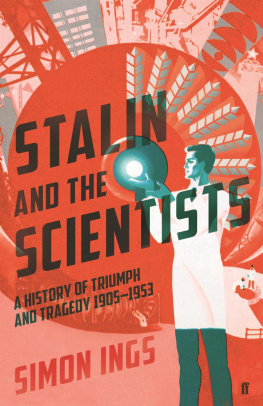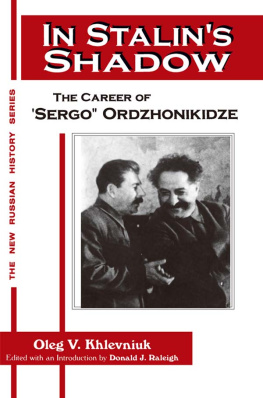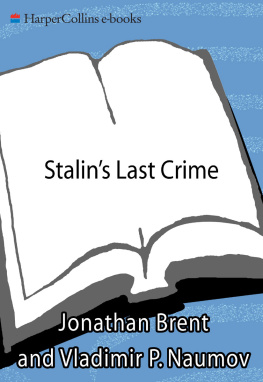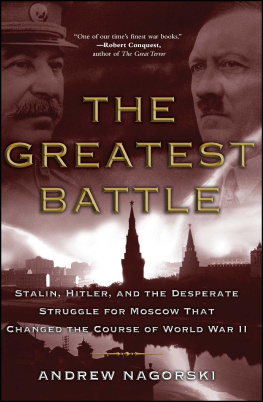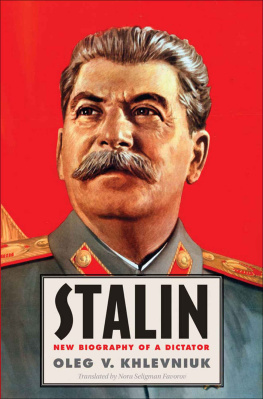Come, brethren, let us look in the tomb at the ashes and dust, from which we were fashioned.
Verse from the Orthodox burial service
This book about more or less the whole of scientific life in the Soviet Union, from its birth until the mid-1950s grew out of my fascination with someone other than Joseph Stalin.
Alexander Romanovich Lurias classic neuropsychological case study The Mind of a Mnemonist was one of the first books of modern popular science: a slim book that shaped a genre. In it, Luria described the strange world of Solomon Shereshevsky, a man with a memory so prodigious it ruined his life.
Some years ago I met another Luria obsessive who wondered aloud if there was room for a new biography. I did some research and hit a wall. Lurias most astonishing achievement, in a career full of astonishing achievements, was his ability to lead a normal life. He betrayed no one, nor was he betrayed. He led a happy family life and enjoyed many close friendships with colleagues abroad. His work was as sound as it was brilliant. Lurias life and work are endlessly fascinating from a scientific point of view but, for a biographer, there is little to tell that has not already been told.
Yet here was a man a Jew in a country goaded by the state into anti-semitism who exposed himself again and again to political risk, who was repeatedly interrogated, sacked and admonished, whose work was forever being banned. Lurias career was an extraordinary demonstration of Winston Churchills adage that success consists of moving undaunted from failure to failure.
To unpick the ambiguities of Lurias quiet life, I realised I would need to explore Lurias world, and the more I explored, the more I came to appreciate the generation from which Luria sprang: young men and women who grew up in revolutionary times and whom Stalin and his government had not yet cowed into obedience.
So this has become a much bigger story: it describes what happened when, early in the twentieth century, a motley handful of impoverished and under-employed graduates, professors and entrepreneurs, collectors and, yes, charlatans, bound themselves to a failing government to create a world superpower.
Russias political elites embraced science, patronised it, fetishised it and even tried to impersonate it. This process reached a head in 1939 when the supreme patron of Soviet science established a prize in his own name for scientific research, the Stalin Prize. At the same time, the supreme national scientific institution, the USSR Academy of Sciences, elected him an honorary member.
Suspected, envied and feared by the Great Scientist himself, scientific disciplines from physics to psychology, genetics to gerontology (a Soviet invention) sought to avert the many crises facing the country: famine, drought, soil exhaustion, war, rampant alcoholism, a huge orphan problem, epidemics and an average life expectancy of thirty years. Their work, writings and wrangles with the political authorities of their day shaped global progress for well over a century.
Tsar Alexander II, a successful war leader and diplomat, was an ambitious moderniser. Coming to power in 1856, he transformed Russias military, its administration and its tax system, and spurred Russias industrialisation. But Alexanders battle to push his country forward went disastrously awry in 1861, when he freed the empires 20 million serfs into poverty and homelessness. The tsar became a target of numerous murder plots and, after several narrow escapes, he was assassinated.
Nicholas II ascended the throne in 1894, by which time Russias growing industrialisation had produced a revolutionary socialist movement. By 1905, following a string of embarrassing military defeats, support for the already unpopular government had dwindled. In St Petersburg, troops fired on a peaceful demonstration, sparking the liberal Revolution of 1905.
The First World War brought another crisis, exposing Russias dismal command of its natural resources. War losses and crop failures caused the economy to collapse and in St Petersburg now called Petrograd riots broke out.
Nicholas II abdicated on 2 March 1917, and a shaky provisional government was declared. On 7 November, led by Vladimir Ilyich Ulyanov (Lenin), the Bolsheviks seized power. But they were far from controlling the whole country, and a bitter civil war ensued. By 1922 Russia was devastated by battles, mass executions and, worst of all, by famine a crisis that inspired many of the extraordinary scientific careers featured here.
Lenins New Economic Policy, introduced in 1921, relaxed the revolutionary governments hold over the economy, reintroduced some limited private business and ushered in a period of extraordinary social and cultural change. Stalins own son attended an experimental school run by psychoanalysts Sabina Spielrein and Vera Shmidt. Alexei Gastev, a poet and a leading architect of Russias industrialisation programme, trained tens of thousands in the subtle art of production-line engineering. His colleague Isaak Spielrein, Sabinas brother, established a psychotechnical community in Russia dedicated to the physical and psychological emancipation of the Soviet worker. Lev Vygotsky and his colleagues Alexander Luria and Alexei Leontiev embarked on a staggeringly ambitious project, rewriting psychology from first principles. The groups belief in practical, clinical experience led them from trauma wards to orphanages, and from the invention of the lie detector to expeditions in remotest Uzbekistan.
Following Lenins death in January 1924, the Communist Party was torn apart by a bitter power struggle. Lenins natural successors, including Trotsky, found themselves marginalised and ultimately destroyed by a man who had barely figured in the 1917 revolution. True, Joseph Stalin had been one of the Bolsheviks chief operatives in the Caucasus. He had organised paramilitary units, incited strikes, spread propaganda and raised money through bank robberies, kidnappings, ransom demands and extortion. But his appointment in 1922 as General Secretary of the Communist Party was not considered significant at the time. What Stalin spotted straight away, however, was that the post gave him control over government appointments. Stalin built up a base of support, emerged victorious from the power struggle and went on to rule the Soviet Union for a quarter of a century, becoming one of the most powerful and murderous dictators in history.
Stalin scrapped Lenins New Economic Policy and replaced it with five-year economic plans dictated from the top. This was good for some scientific disciplines, guaranteeing them virtually unlimited funds. For others it was a disaster.

